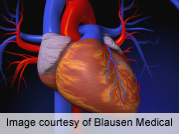
THURSDAY, May 10 (HealthDay News) — A new treatment that involves spinning bone marrow stem cells to enhance their healing potential may help people with advanced heart failure feel and function better, a small study suggests.
Researchers developed the treatment by culturing a patient’s own bone marrow for 12 days. This process helped increase the amount of immune cells and stem cells that can differentiate into several different cell types, including heart cells. Those cells were then injected into heart muscle. The study was funded by treatment manufacturer Aastrom Biosciences.
According to the findings, this treatment was safe, helped repair the damaged heart muscle and reversed some heart failure symptoms, when compared to a placebo injection. The findings were to be presented Thursday at the Society for Cardiovascular Angiography and Interventions annual meeting, in Las Vegas.
The U.S. National Heart, Lung, and Blood Institute reports that about 5.8 million people in the United States have heart failure, a condition that occurs when the heart can no longer pump enough blood to meet the body’s needs. Symptoms include shortness of breath, fatigue and swelling in the ankles, feet, legs and abdomen. There is no cure; treatment typically includes a cocktail of medications aimed at reducing symptoms and improving quality of life.
“A number of people with heart failure have slowly progressing disease despite medication and/or device therapy. If we could have a therapy for this group that would slow the progression of heart failure, it would be economic and change the disease process tremendously,” said study author Dr. Timothy Henry, director of research and an interventional cardiologist at the Minneapolis Heart Institute at Abbott Northwestern Hospital in Minneapolis. The treatment would not be used for people who need a heart transplant.
Calling it the next generation of stem cell therapy, Henry said the treatment process helps enhance the potency of existing stem cells. “It gives a more functional product,” and when injected these stem cells may promote the growth of new blood vessels, he added.
Further study is ongoing, and if the results are positive a product could be available within two years to treat inadequate blood supply to the legs, and soon thereafter for heart failure, he said. According to Henry, six or seven new products that enhance bone marrow stem cells are being developed. “Ask your doctor if you are a candidate for any of the clinical trials,” Henry advised.
The new study included 22 participants with advanced heart failure and an enlarged heart whose current medication regimen was no longer effective. They either received an injection of the stem cell therapy treatment into their heart muscles or a placebo shot. After 12 months, there were no complications and no difference in side effects among those who received the stem cells and the control group. That said, individuals who received the novel stem cell therapy did have a lower number of major heart-related events and were more likely to see improvements in their ability to walk without growing breathless. Those who received the stem cell treatment also showed marked improvements in their ejection fraction, which is a measure of how much blood leaves the heart with each pump.
“This study tells us that injecting stem cells into the heart muscle of a patient with chronic heart failure may be beneficial,” says Dr. Sandeep Jauhar, director of the congestive heart failure program at Long Island Jewish Medical Center in New Hyde Park, N.Y. Typically, these individuals are treated with multiple medications, put on a low-salt diet and encouraged to get some exercise.
“The available medications are very effective and people live a lot longer than they used to because of the drugs we have developed,” he said. But many people reach a ceiling in terms of how effective the medications are, he added.
“We do need a new way of treating heart failure if we want more improvement,” said Jauhar, who added that it is too early to say whether the new stem cell therapy will fill that role. “It shows some improvement in pumping parameters of the heart, but that doesn’t mean you will live longer,” he said.
This is a small study that suggests the treatment is safe, said Dr. Kirk Garrett, clinical director of interventional cardiovascular research at Lenox Hill Hospital in New York City. “The approach is different in that most other groups zero in on one gene or cell type, and try to make it do the work,” he said, while the new treatment involves both stem cells and immune cells that are primed to do the job.
Because this study was presented at a medical meeting, the data and conclusions should be viewed as preliminary until published in a peer-reviewed journal.
More information
Learn more about heart failure and how it is treated at the U.S. National Heart, Lung, and Blood Institute.

